This article is so comprehensive that I had to separate it out from my post on cleaning and maintaining workout equipment.
So you just got a new olympic bar and you want to keep it in good condition for years to come. See our section below on regular maintenance.
Or maybe you have an old rusty bar and you want to clean the rust from the outside, or maybe even clean out the inside of the sleeves. It’s a piece of cake if you know how to clean a rusty barbell.
Table of Contents
Materials
Minimum for External Cleaning and Maintenance
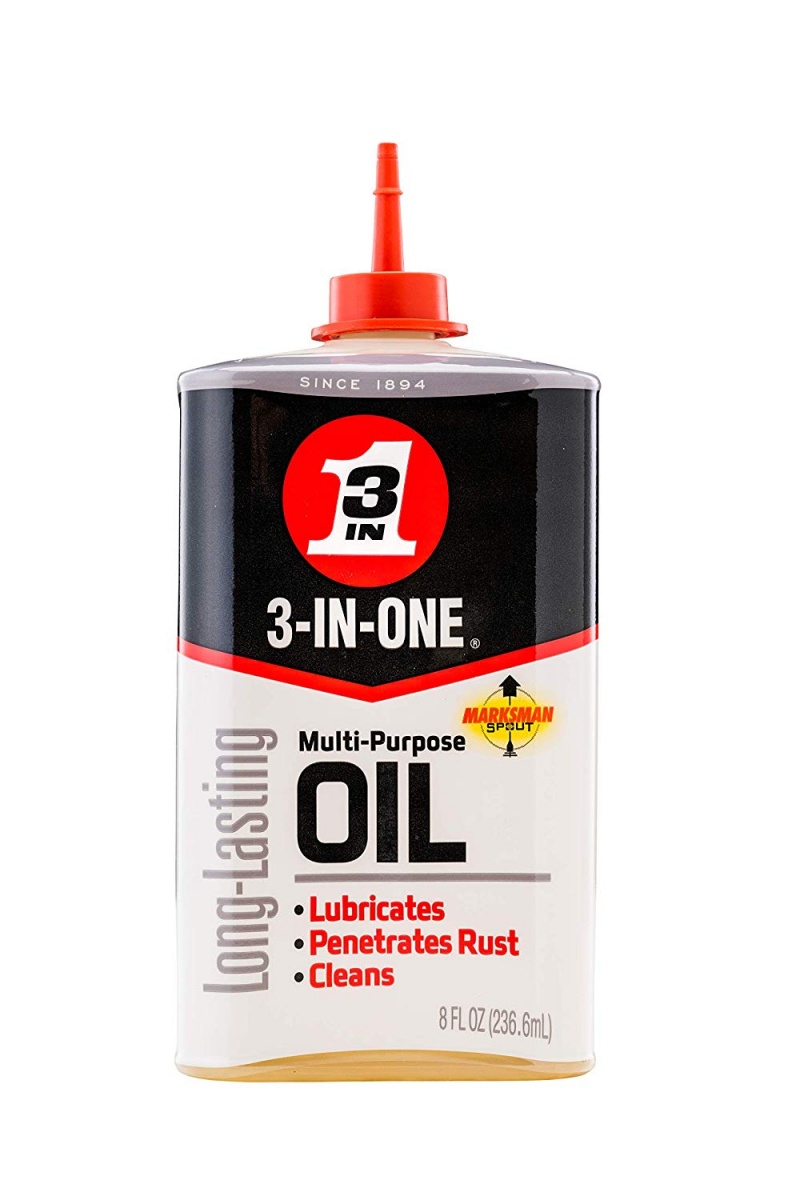

First, you need some kind of light oil like one of the above. Do not try to use vegetable oil, which will turn rancid. Motor oil is too thick and stinky. WD-40 leaves a slightly toxic coating that you don’t want to be touching all the time.
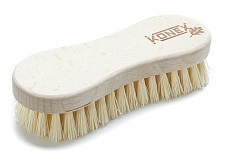
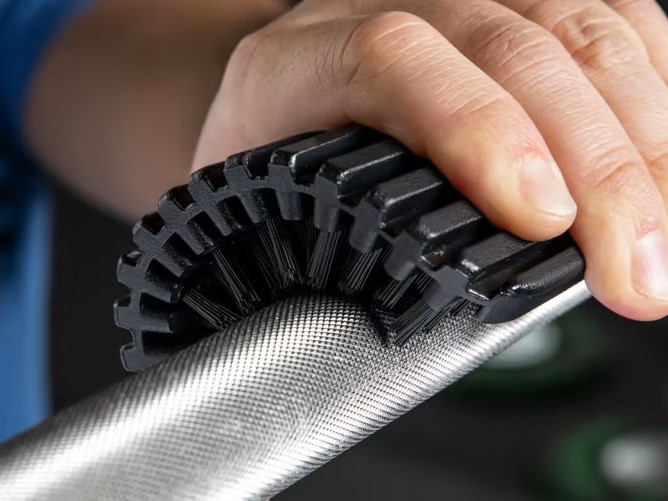
Next is a brush. Any white or “natural” colored stiff bristle nylon brush will do. Do not get one with brightly colored bristles, because the dye will likely come off onto your bar’s knurl. It happened to me.
Hybrid Athletics makes the 360 Brush designed for bars. It’s nylon bristles with a flexible silicone back to accommodate a curved surface like a bar to make brushing a quick job.
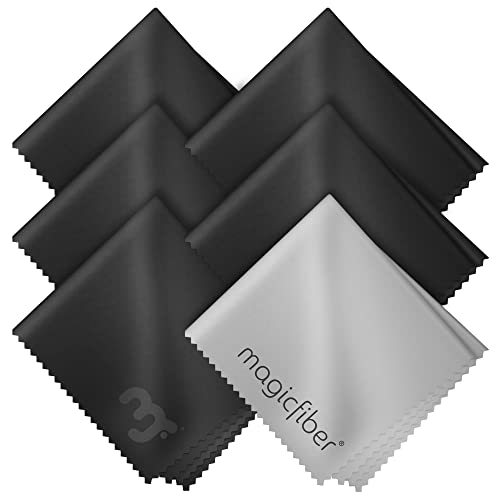
Next, microfiber cloths. They have to be type pictured above, not the car detailing towels that will leave themselves all over the bar’s knurl. The right type are often included with electronics and sunglasses for wiping off optical surfaces. In this application they’re great because they’re as lint-free as you can get. Even with these you might need to brush a few threads out out of aggressively knurled bars with the nylon brush.
For More Serious Cleaning
Just the single brass hand brush above will do the job for small work. After nylon, it’s always best to try brass. It’s a soft metal that will not scratch your steel bar. Stainless steel is harder but still softer than carbon steel bars, which are the large majority. I discuss all this further below.
Several more tools above for disassembling and serious cleaning may come in useful, depending on what steps you follow in this guide.
External Rust
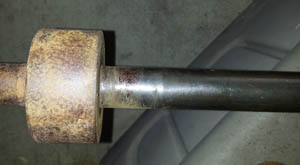
First you need to deal with any rust on the outside, whether it’s all over or just starting to form.
Patina Coated Barbells
Patina is a thin, inactive rust that forms from minimal exposure to moisture over time. It’s actually fine. It is a type of rust that has formed slowly over the years and is not getting out of control. It actually forms a coating over the bar to protect it.
This usually happens with bare steel bars, or on bars that were originally coated with something like black oxide or zinc but on which the coating has worn off over time, as those coatings tend to do.
You can tell visually and by touching it. Patina has a shiny, smooth appearance like other bars that are in good condition. If it looks like that’s the case, rub your hands all over it. If if feels smooth, that’s good. If your palms turn brown at all, you’ve got bad rust that you need to do something about. Otherwise it’s patina and it will be fine for many years if you don’t hang up your bar every day with wet chalk all over it.
For any bad rust, you’ll need to take action on it, as per below. You don’t want it coming off on your hands during your workouts and getting in your eyes. Rust is merely iron oxide and is not considered toxic, but you don’t want it.
Cerakote, Black Oxide, E-Coat, Bright Zinc, or Black Zinc Coated Barbells
For these coatings, use the stiff nylon brush. Anything else will rub off the finish. These particular finishes are prone to rubbing off from the abrasion of the J-cups (bar holders) on a rack, even if the cups are lined with UHMW plastic. Even your hands can start rubbing it off. So as you might imagine, anything more harsh than a nylon brush will strip the coating.
If the nylon brush isn’t cleaning the knurling good enough, drip some 3-in-One oil onto it to help mobilize the rust or gunk in the knurling.
If the rust is too deep, or you’re resigned to losing the finish in order to get the rust off, then go ahead and use a brass wire brush to turn it into a bare steel bar as below.
Chrome Plated Barbells
The large majority of rusty bars out there are chrome plated.
The chrome may be chipping off in spots. If that’s the case, you most likely are going to find rust underneath the chrome. You will have to take a wire brush to it and remove all the chrome and rust.
Use a brass wire brush. Brass is softer than chrome and won’t scratch it up. Or it shouldn’t. If you start chipping away at the chrome with a brass brush, it’s basically already coming off anyway and you did good by helping it along.
If that doesn’t do the job, go with a stainless steel wire brush, which is softer than the carbon steel most commonly used in bars and won’t scratch it.
In either case, a drill mounted brush will be the easiest and most powerful for cleaning off an entire bar.
Stainless Steel Bars
If you’re unsure what you have, it isn’t likely to be stainless steel. Chrome bars probably outnumber stainless steel bars 1000 to 1. Flaking chrome is obvious. It looks like flaking paint.
In any case, a stainless steel wire brush will dig some scratches into a stainless steel bar. Go with brass or nylon only, as described above.
Oiling the Outside
Factory Oil
First of all, if your bar came with a layer of dark oil on it, wipe that crap off. That oil is put on at the end of the manufacturing process to protect the bar from corrosion while in storage and being shipped around the world. They seem to like to use a thicker brown oil for some reason. I’m no oil expert, so whatever. But wipe it off. You don’t need it getting all over your hands, clothes, equipment and floor.
Oiling Method
Bare carbon steel bars need oil more than any other bars, given that there’s nothing protecting it from moisture at all. Black oxide coated bars also need oil. The black oxide coating is designed to protect against rust only when it can interact with oil. I had a black oxide bar for a few years, but it was kept in the back room, not a garage, and usually with the back door closed, so the moisture exposure was limited to sweat. It did develop a patina pretty quickly where the black oxide had worn off in the center, but no active rust. I rarely oiled it.
With other finishes, it’s up to you. A stainless steel bar is protected against rust like nothing else, so unless it’s actually stored outside then you don’t need to worry about it. Cerakote is the same way. Chrome is nearly as good. Zinc could use some oil.
But your bar doesn’t have to feel oily or slippery. Here’s what you do.
Wipe the oil all over the bar with a cloth, including the shaft and sleeves. Always use a lint-free cloth on your bar for cleaning or oiling, or the knurling will grab onto all the fibers it can and make a mess. Coat everything well. The oil protects the bar from being exposed to moisture. Wipe it down good enough so that nothing will drip. For best results, leave that thin layer of oil on overnight to give it time to fully penetrate into the surface.
In the morning, or right away if you’re impatient, wipe the bar down good with your clean cloth to remove the excess oil. There will be a thin layer of oil left on the bar even after a good wiping down with a fresh cloth, and that will do the job without getting your hands oily when you use it. You won’t feel the oil, but enough of it will stay on to be effective.
If the cloth leaves any lint, brush it off with the nylon brush.
Oil the Sleeves
If the collars don’t spin smoothly, the oil or grease on the bushings/bearings inside might have dried up, or there could be rust buildup.
If you want to get oil into the sleeves to help the spin, you can set the bar vertically and drip oil from the shaft and let it run under the sleeves. Let the bar sit vertically overnight so that the oil drips fully down the sleeve. Then in the morning spin the sleeves to distribute the oil. This should help the sleeves spin as smoothly as possible, particularly important if you’re doing olympic lifts. Flip it over and do the same for the other sleeve.
But before doing this, it’s nice to know whether the sleeves have oil or grease inside. You could be flushing the grease by introducing oil. 3-in-One oil actually has a warning on it that it breaks down teflon grease.
Disassembling the Barbell for Thorough Cleaning and Oiling
If you’re feeling adventurous, you should be able to remove the sleeves. It all depends on what’s holding the sleeve on and whether the corrosion has frozen things into place.
Here are the different types of methods that barbell sleeves are secured by, and how to remove them for internal barbell maintenance.
Removing a Hex Bolt
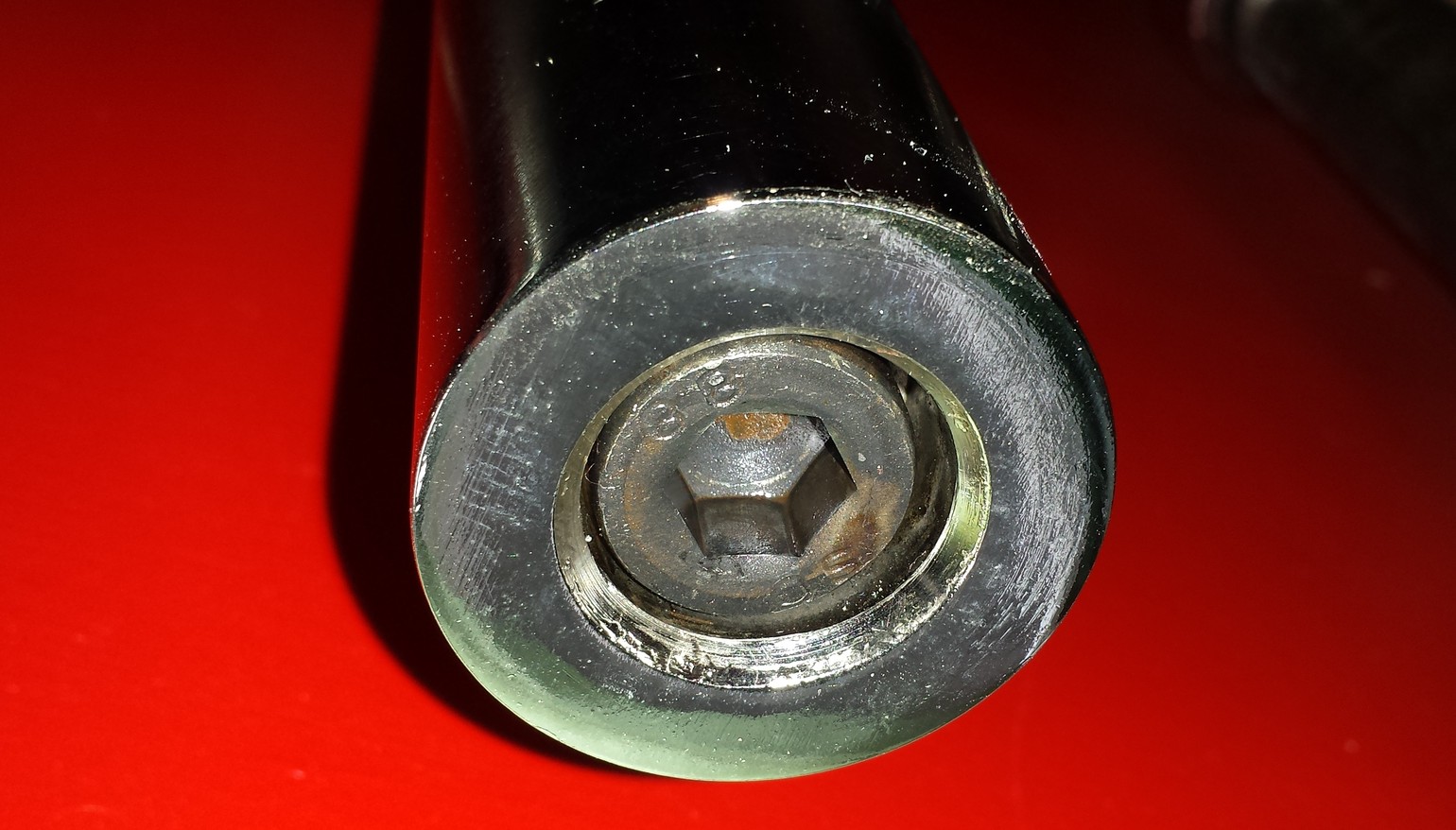
If it’s a cheaper bar with a hex bolt on the end, you can remove it with an allen key (usually 3/8″). If it’s frozen, try taking a heat gun to it first to soften it up. That will also loosen any Loctite that someone might have applied to the bolt.
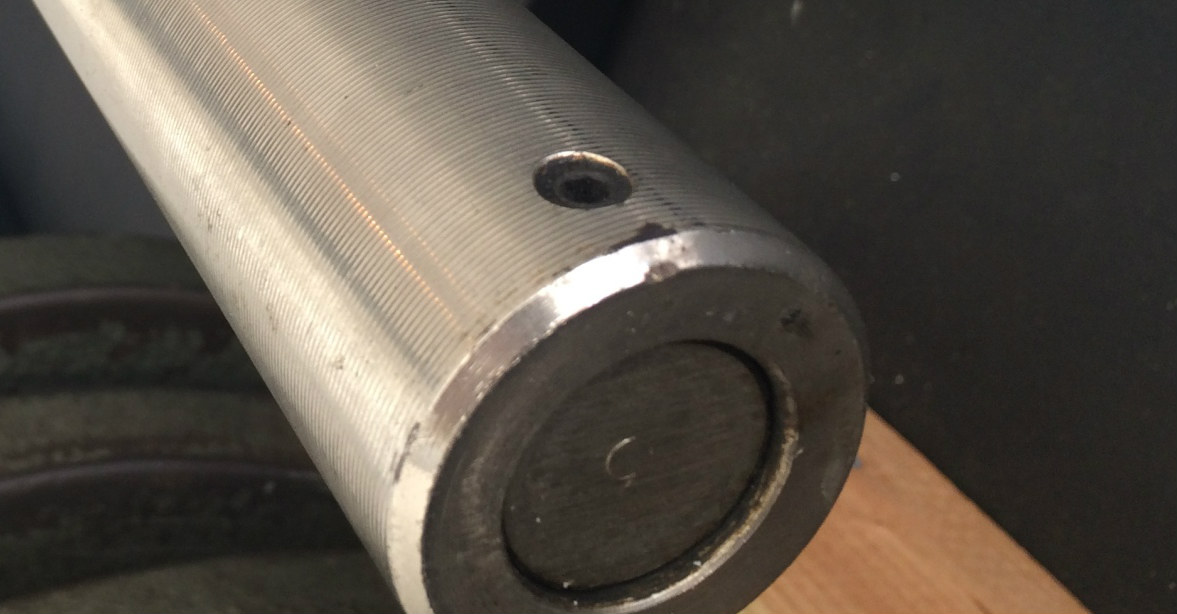
Removing a Punch Pin
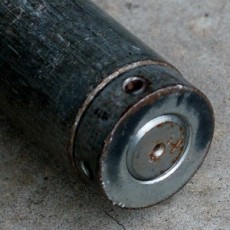
York bars and Texas bars have these. Some older bars used to be made with these too.
A punch pin is in the same location as the last picture above, but there’s no hex head on it. It’s a smooth, solid steel pin that was pounded into the hole with a hammer and punch. It goes all the way through the bar sleeve, and you can get at it from either side.
It can be pounded out, the same way it was put in. You’ll need a punch and hammer to get it out. Also some kind of clamp or other method to keep the bar from rolling.
Removing a Snap Ring
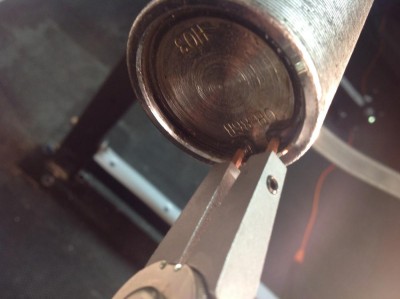
This looks totally different than the above methods and is the most common method now for modern high quality bars.
You can get a snap ring off with snap ring pliers (also called retaining ring pliers). It can be very hard to remove with any other type of pliers. Some newer bars have two snap rings on each end.
Next Steps
Once you have removed whatever mechanism holds the sleeve on, you might need to pound the sleeve loose. Get a rubber mallet, or stick a piece of wood against it and hammer it, to get the sleeve to slide off.
There could be several more bushings or another set of rings to remove, depending on the bar. Here’s a good video from Alan Thrall on disassembling a bar with a surprising number of parts to keep track of. Be ready for the possibility.
When you have it apart, look it over. If there’s rust, brush off everything you can get to, and clean it with a rust remover. Wipe away gunk with a lint-free cloth.
Josh in the comments at the bottom of this post mentioned using a PVC pipe for a vinegar soak to remove rust. Great idea! You just need a 2″ PVC pipe with at least one end cap and a lot of vinegar. This will affect the oil/grease inside the sleeves, so only do this if you disassembled the bar or plan on doing so.
Next you need to pack teflon grease into the bushings or bearings to lessen the friction between them and the sleeves. Grease will keep the sleeves spinning well for longer, and absorb more dirt, than if you used oil. Oil is best just for the outside.
A lot of new bars nowadays are sealed to keep the grease inside the sleeves and prevent this whole situation from happening, but if the sleeves are spinning badly then that probably isn’t the case with your bar, so you don’t need to worry about sealing anything up. Or else the rust has gotten bad despite the grease, and you have to do something. Still, even if it was sealed, sealing it should be just a matter of getting the right amount of grease everywhere so you can still push the sleeves on and re-tighten what ever is holding them on.
Bodybuilding.com has a great thread on a poster’s project of disassembling, cleaning, and rebuilding a bar.
Periodic Barbell Maintenance
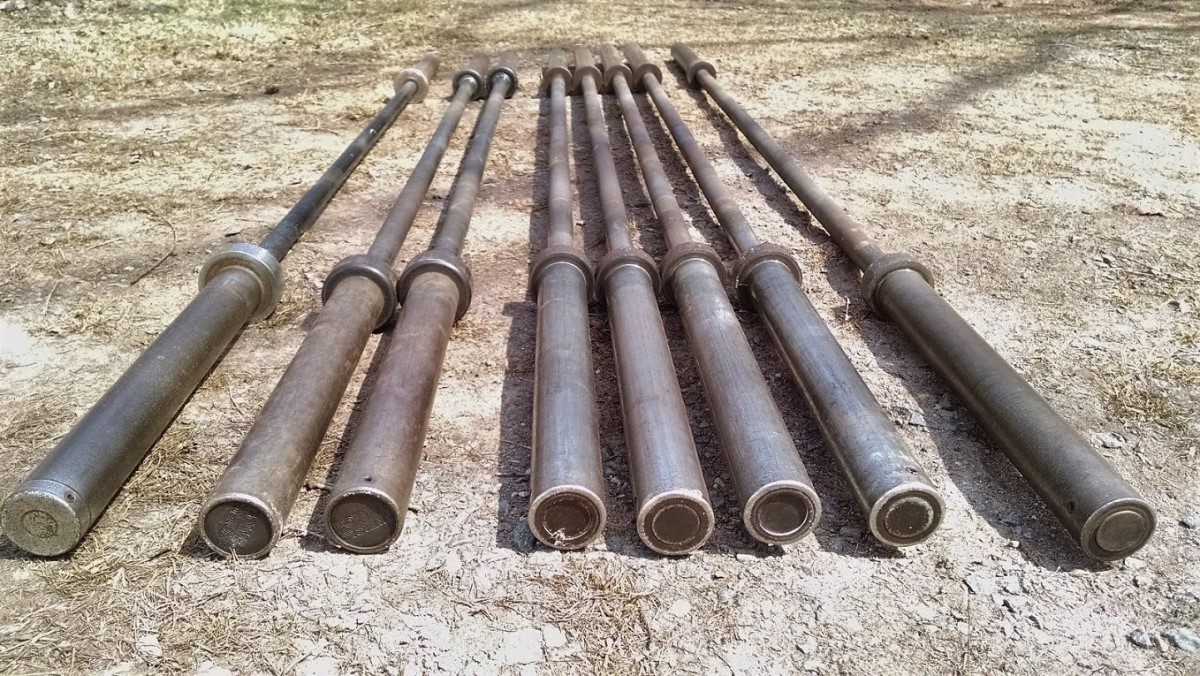
source: STR8OUT at https://forum.bodybuilding.com/showthread.php?t=115122621&p=1353386611&viewfull=1#post1353386611
Once you’ve done the initial cleaning, you don’t have to do much to keep your bar in great shape. Once a week or even once a month, brush the dead skin out of the knurling with a nylon brush, with the help of oil if necessary, and wipe it down with an oily cloth.
I’ve heard of OCD people doing it every day. Once a week might be unnecessary. You might be able to go months. It depends on how much you sweat and how humid of an environment it’s in. After several workouts you’re probably going to rub off most of the oil from some parts of the shaft, or there will be enough salts from your hands that you want to get off.
If you use chalk, you’ll need to clean the chalk out of the knurling with your brush every day, and it’s best to then wipe it down with oil. Chalk will hold moisture, which will cause rust in no time at all if you leave it there.
Storing a bar vertically can cause the oil inside the sleeves to gather at one end of each sleeve, so if you’re going to do that, at least flip it over each time you put it back in (if you can keep track of the direction). A wall-mounted horizontal bar rack will avoid this issue.
Bar sleeves that are packed with grease, as I describe how to do above, shouldn’t have an issue with how the bar is stored, vertically or horizontally.
Also see Norcal Crossfit‘s video on cleaning:
Rogue made a video below on disassembling and cleaning their bars, which somewhat applies to other brands. There are more parts than you thought were in there, huh?
Giving Up? A New Bar Can be Inexpensive
Don’t fix it, throw it out and get a new one!
Hey, I understand. It can be too much investment of time or money to refurbish an old bar. Fortunately, you can get a decent bar for under $200.
Or if you have the cash and want to make an even smarter investment on a bar that will be up to the task as you get stronger over the years, see our evaluation of the best all-purpose olympic bar.

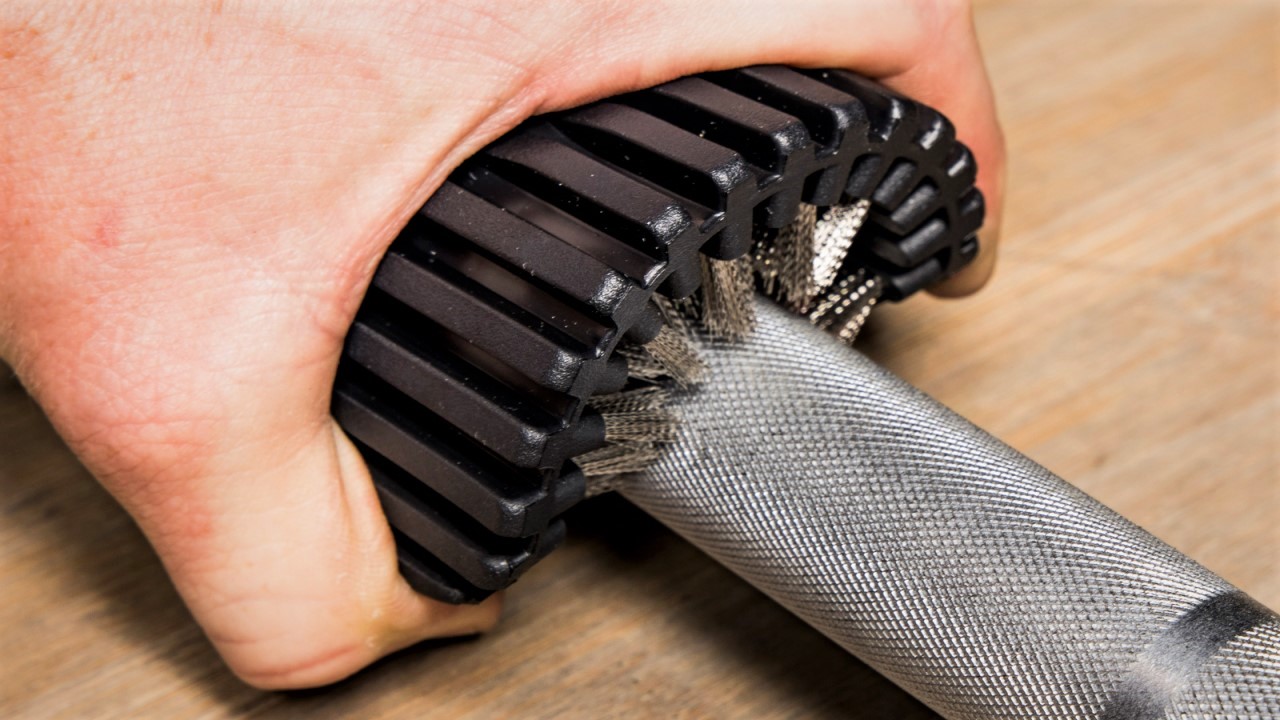
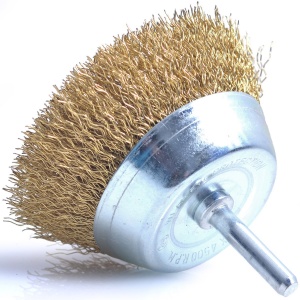
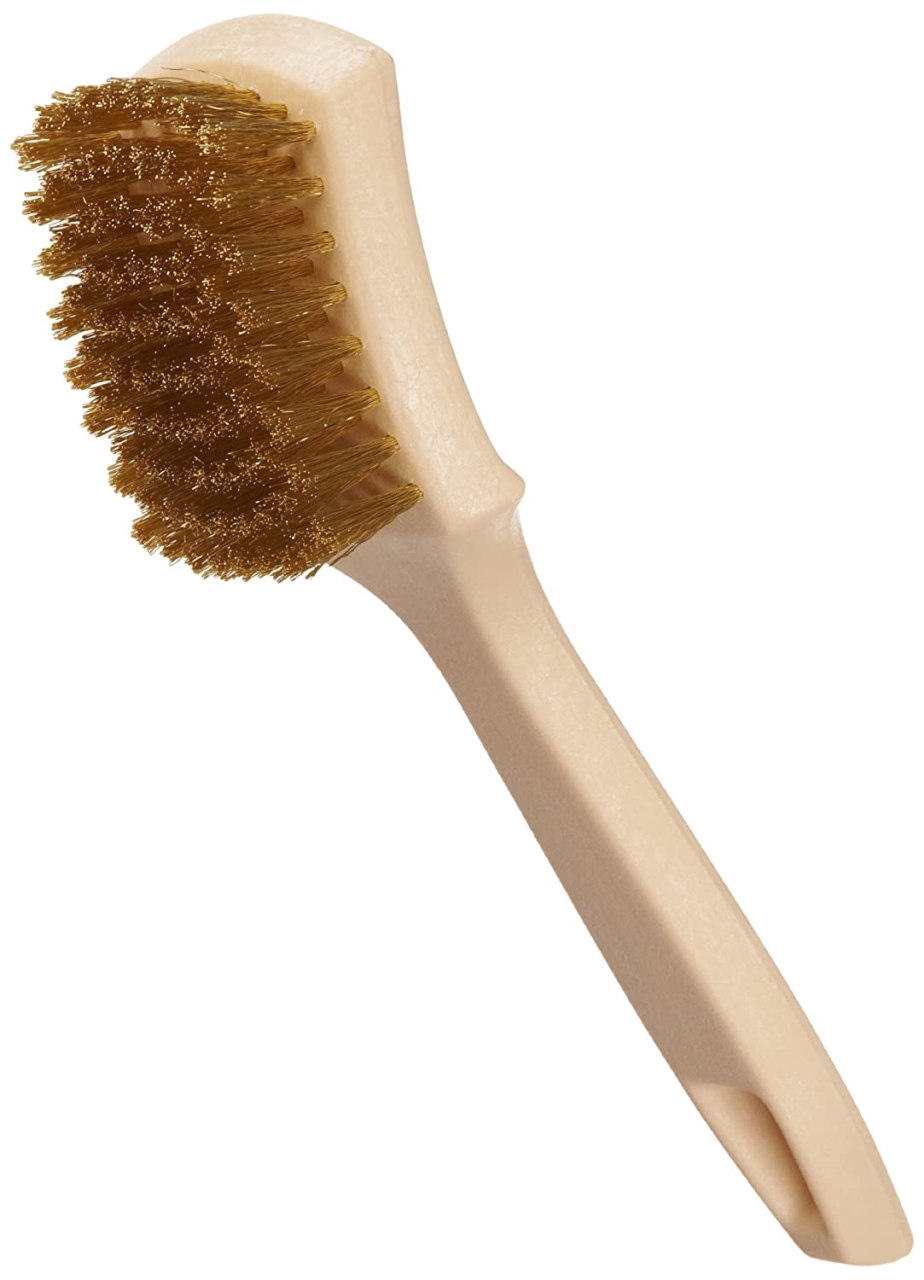
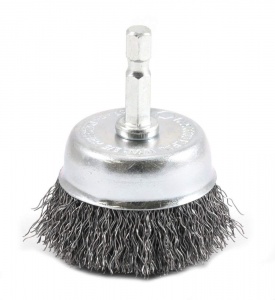
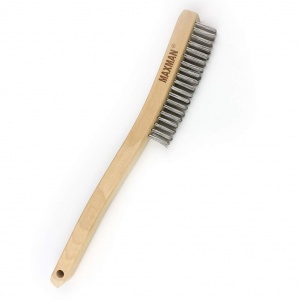
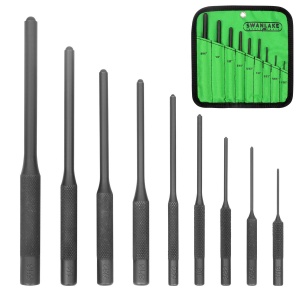
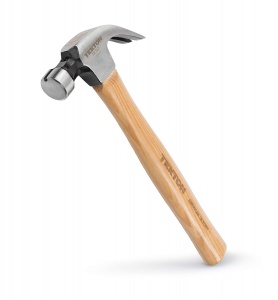
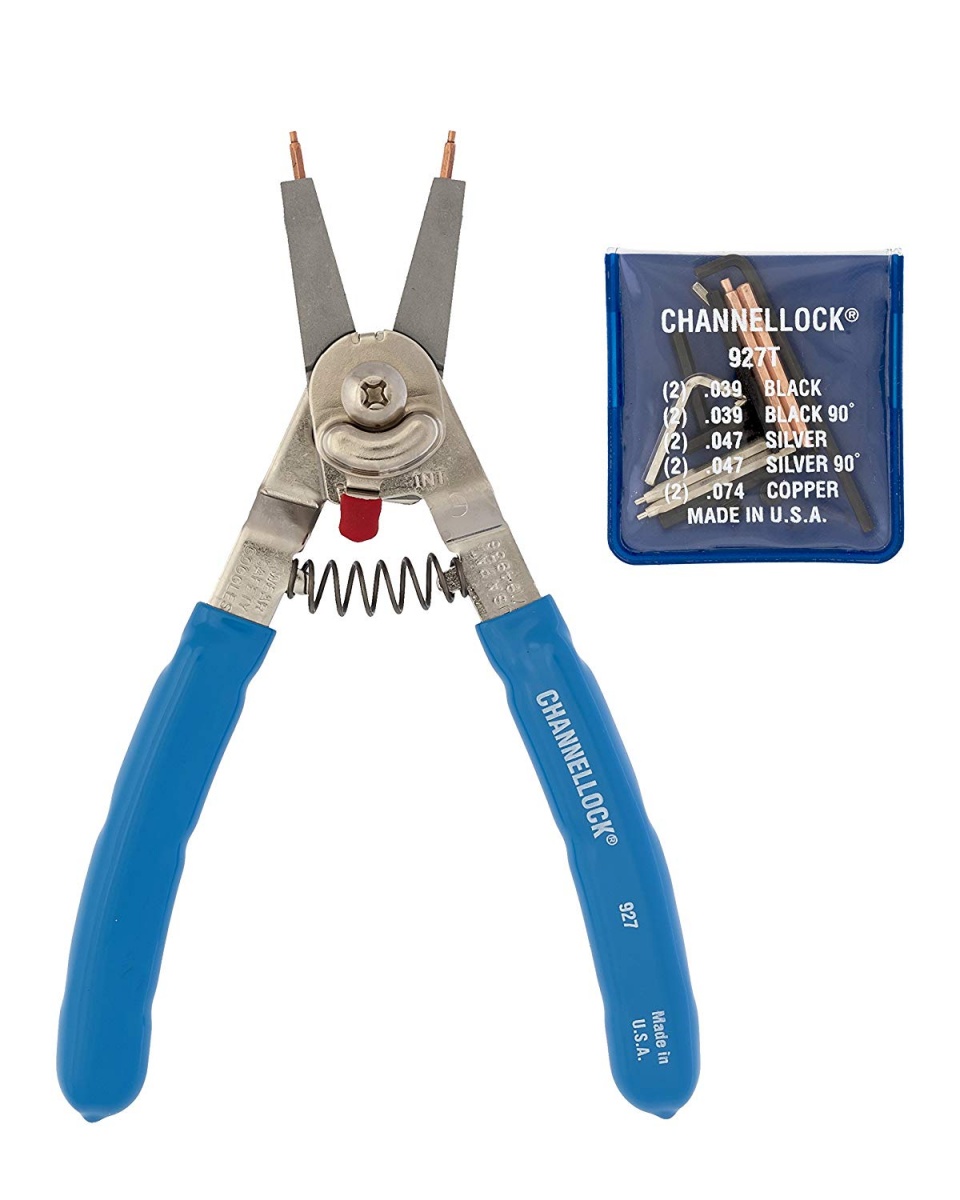
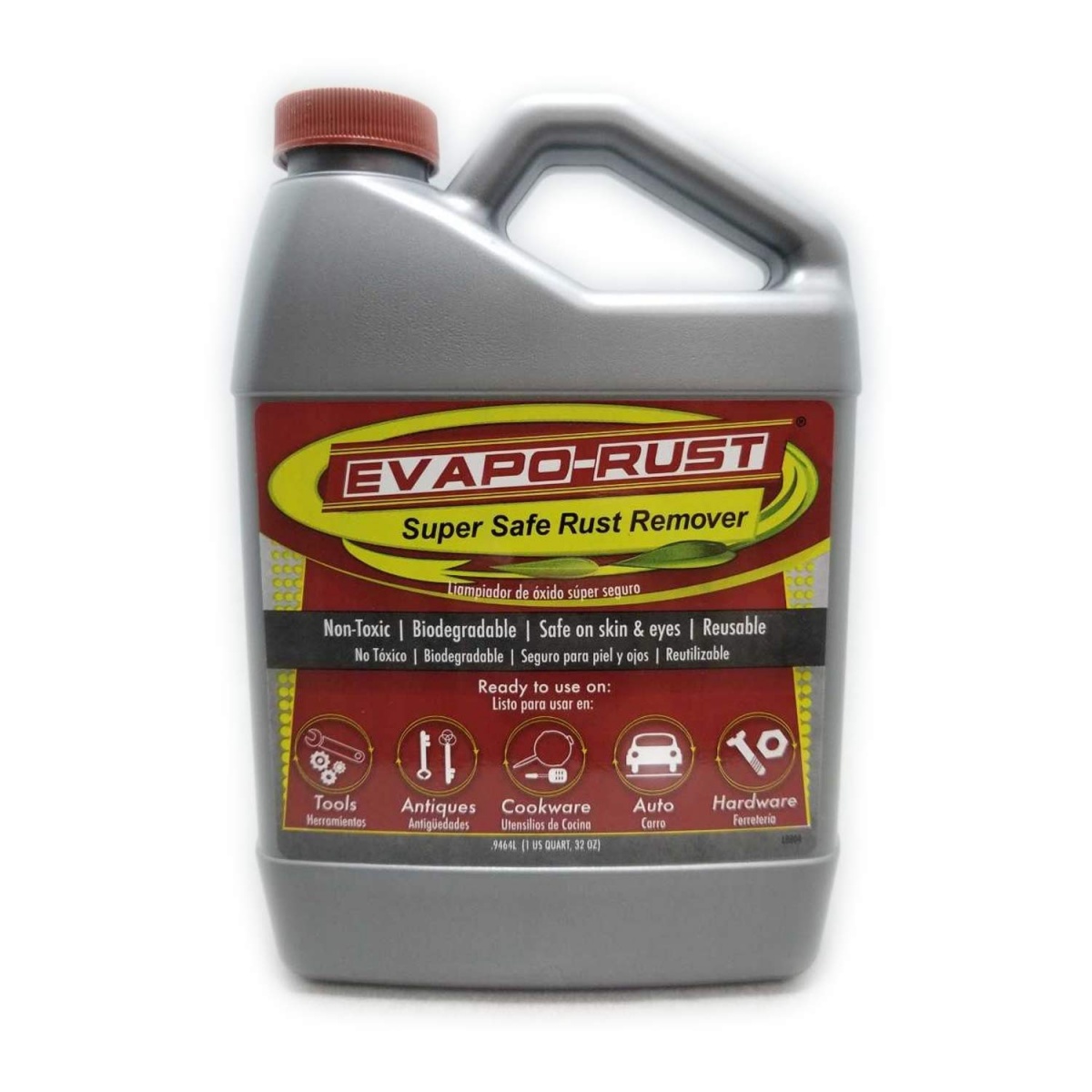
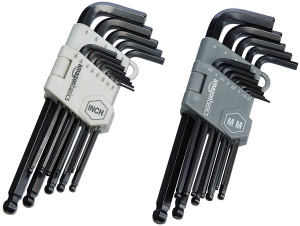

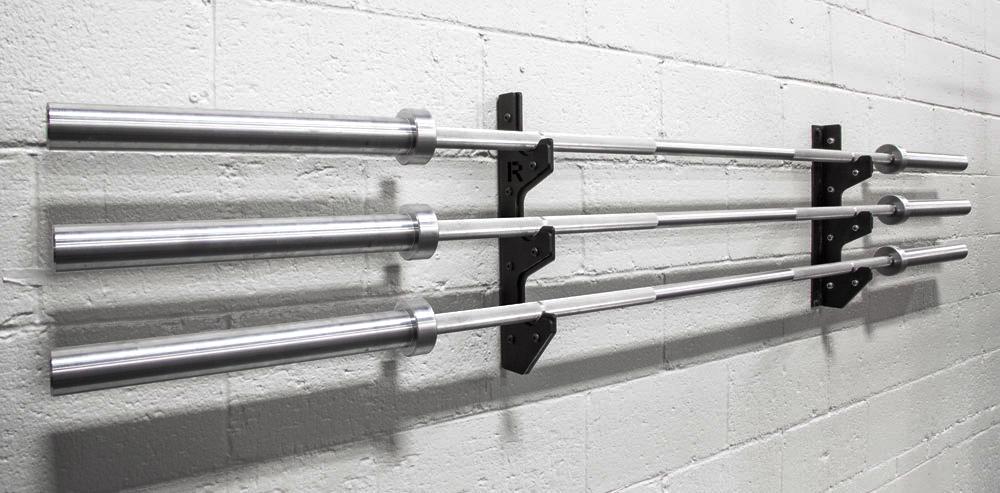
Hi David
Thanks for this awesome article.
But I need a simple fix.
I dont have any of these tools or a male to assist.
My bar isn’t spinning great. How can I change that without disassembling the bar or using oil that might sacrifice the grease on the inside (or whats left of it).
Without tools my best idea is to try to shoot a lot of WD-40 into the sleeve from the middle of the bar, spin the sleeve to try to get it all around, let it sit a couple hours to dissolve some rust, and then shoot a lot of oil in. I don’t know how successful that would be. Definitely messy.
Came across this post as I found a old York bar going for 250 , since ive been looking for a used bar to start working out at home. I was wondering if this bar is worth restoring and using it or am i just better off buying a Boneyard bar from Rogue? Which i think is the side that im heading towards.
Images of bar: https://imgur.com/gallery/8G7rsWg
That’s pricey for an old rusty bar that you have to clean up. An old York bar with the original split sleeve design like that is a collector’s item for sure, but I don’t know how much they go for among collectors.
Great article and very helpful. I’m actually in the process of doing this now and I got impatient and brushed the rust off while it was soaking in vinegar after 12 hours. I can’t believe how great the collars look already. To soak the bar itself, I went and got a stick of two inch PVC and filled with 1.5 gallons of vinegar.
The only thing I would add is that when removing the smaller style hex bolts there will be ball bearings that could easily get lost or fall out. May be common sense to most, I don’t know. Either way, great article, very informative, and very accurate. Thanks for the help!
Pretty amazing what can be underneath what looks like a ruined bar! That’s a great idea with sticking it in the PVC pipe to soak. I’m going to have to add that to the article. You’re right about the extra pieces like bearings too. Some bars have a bunch of rings and sleeves in there to keep track of.
Very Informative, thank you!
Great information.!!
I have been puddled about a bar I recently brought and could not find another like it until I came across your article.
Could you please help?
May I know what type of bars “the two paired together second and third in from the left” in the article image are? And do the sleeves spin on them?
I have purchased one that was rusted up and I have given it a clean but the sleeves are solid. The guy eho sold me it said that it was not meant to spin 🤔 it came along with 2 rare vintage 15kg york olympic weights which makes me wonder if the bar is also vintage.
I did not pay a fortune but I would love to add it as a show piece if I can not make a little change on it.
I’m not sure what bars they are, but as far as the one you got, anything with sleeves like this is meant to spin. Only standard bars or some specialty shaped bars don’t spin. Good score with the York vintage plates though!
My apologies I’m new to post in on forum discussions.
The pin is is on one side towards the end cap of the sleeve.
I would definitely try the WD-40 on the pin. I did try WV14 in the bushings but they didn’t budge.
It should be just a single piece holding the sleeve on, either a pin, bolt, or snap ring. The sleeve will slide off once that’s removed, or if it’s stuck it should with some pounding.
Thanks Coach Mickey and Alex!
I am over here in Thailand. we have over 50 Oly bars that are being kept outside! Today I could not train because of minor staph infection so I began to remove the incredible rust from the bars. I did two of them today. Now I have been tasked with doing them all! The rust is so bad I have to grind it off with power tools and abrasive wheel. These bars are about 6 months old! Here in Thailand we do not have Lowes or Home Depot, we have Home Marts with limited selections. I really want to help Tiger Muay Thai and Chalong Crossfit any suggestions for rust inhibitors after I mechanically remove as much rust as possible (there is some deep pitting). Thanks for your help!
Bill Berry
Level 1 CF
Former Norcal
Trained at 9 CF’s now
Yikes! You better get on it right away.
Since they’re all rusted pretty good, after you brush all the rust off that you can, apply a rust converter. It comes in a can or jug. The key ingredient is tannic acid, which converts rust into an inert black substance. Essentially you’re deactivating the rust. Wait 24 hours, then brush off that stuff too.
You could take the sleeves off all the bars and clean inside too, but that’s a lot of work for 50 bars. The easiest thing you could do is apply a generous amount of mineral oil or 3-in-One oil to the bars regularly. Any kind of good permanent coating is difficult to apply without professional equipment, so oiling is the best thing.
So chances are it is rusted internally and not spinning.
I attempted pushing the punch in on the cap to release the sleeve and broke a bolt extractor in the ordeal (it is still stuck in there and now doing the job of the punch)
Do you have any tips on how to remove the punch pins the right way?
Jai, you replied to my comment to somebody else, so hopefully you saw my reply to you too.
Is it a bolt, or a pin that goes all the way through? A bolt won’t punch out no matter how hard you hit it, and that could be pretty hard to remove if it’s stuck. Either way, WD-40 sitting on it for a few hours might loosen it.
Hi sorry about that that I’m pretty new to this.
It is a pin that holds the end cap on, or I think it is, and once I can get the cap off I will see if it is a Bolt or snap rings holding the bushing on.
Article is very helpful.